How to Modernize Legacy Applications - Step By Step Guide
Table Of Contents

In today’s digital age, an organization’s system or software can either make or break the game, when it comes to expanding or getting a competitive edge. This means the software's capabilities to keep up with the dynamic business needs is something that can’t be ignored. This is where a well-thought strategy for modernizing a legacy application comes in.
According to IDC, most legacy applications will likely undergo modernization by 2025. And, 65% of these applications will likely leverage cloud services to improve the overall functionality or replace the old code. Clearly, modernizing legacy systems will be a prevalent trend in 2025.
However, legacy system modernization is a complex process that requires careful planning. So in this blog post, we will guide you how to modernize legacy applications with essential steps in building a practical application modernization roadmap and how to overcome challenges that come along with the process.
What Are Legacy Applications?
A legacy application or legacy app is an old or outdated software program, technology, or process a company uses. In simple words, when a system or software is no longer able to keep up with an organization’s needs, it is called a legacy system. These systems often have been in operation for many years and may not be actively supported or maintained by the original developers or vendors.
Over time, old systems need to be updated to avoid bigger problems. As the people who know how to maintain them retire, it gets harder and more expensive to keep them running smoothly. Eventually, the issues with these outdated systems become too serious to ignore. It’s like a leaking roof—you can patch it up for a while, but eventually, the whole structure could collapse if you don’t fix the problem.
Although many large enterprises still use legacy apps, maintaining them is challenging. Legacy apps may also not be compatible with new browsers, operating systems (OSes), or IT infrastructures. For example, software made for Windows 7 may not function well on Windows 10.
There are several reasons for firms to continue working with their tried-and-true old software. In some cases, it might be too expensive to replace an old app. In other cases, the legacy app might also be so tightly integrated with other systems that replacing it would be a huge hassle.
Legacy apps are highly unstable, which makes them frustrating for users, dangerous for security, and a pain to keep up to date. To address these problems, more than 85% of C-suite executives prioritize modernization of legacy applications.
Legacy systems often rely on outdated tech stacks like:
- COBOL
- C
- Visual Basic
- .Net
- Delphi
- Object Pascal
- Fortran
- Perl
How to Identify A Legacy System?
A legacy system may require modernization if you encounter any of the following:
- The software no longer meets evolving business requirements and objectives.
- It does not get security updates.
- The cost to maintain legacy systems is too high.
- The system causes errors.
- Getting support for legacy systems is challenging.
- It does not integrate with modern software.
- A legacy system takes a while to load or run and has several redundant features that offer no functionality.
- Software vendor has stopped providing support or updates.
Are you experiencing the same while using your old system? It is time to modernize your legacy applications. Legacy application modernization involves adding new features to an old system, updating the IT infrastructure, and improving the architecture. This not only addresses the limitations of the old system, but also ensures that the system aligns with the latest industry trends, ever-changing business requirements, and security standards.
Unlock the potential of your business with modernized applications!
Don't let legacy systems hold you back. Explore our comprehensive legacy application migration services and propel your business forward.
Risks & Challenges Of Legacy Applications
Here are some risks and challenges associated with legacy applications:
- Outdated technology: Legacy applications often rely on technology that is no longer supported or compatible with modern systems. Because these technologies are so old, they might not work with the latest rules and suggested practices, making it challenging to maintain and integrate them with newer software and platforms.
- Inefficient performance: They hinder performance due to slow response times and inefficiency, thus reducing their usefulness and efficiency.
- Security vulnerabilities: Older apps are more likely to have security vulnerabilities because they don't use modern security protocols or get updated more often.
- High maintenance costs: Outdated systems cost more to maintain over time. Finding IT professionals with the expertise to keep the systems running smoothly is becoming more complex, as is sourcing the necessary hardware and software components.
- Limited scalability: It can be difficult and expensive to scale these systems to meet increasing demands.
- Compliance Risks: Old systems may not meet the requirements of the GDPR and CCPA, which are privacy and data protection laws currently in effect. Because of this, a company could be fined heavily and have other legal problems.
- Compatibility issues: Converting data into a format that new systems can use while ensuring integrity can be complex.
- Data loss risks: There is a risk of data loss during the migration process, especially if the data in legacy systems is not well-structured.
- Security concerns: Ensuring data security during migration is essential.
- System downtime: Minimizing this downtime while ensuring a smooth migration is a significant challenge.
- Data volume and complexity: Legacy systems can accumulate vast amounts of data over time.
- Data integrity and quality: Data in legacy systems might have quality issues, such as duplications, inconsistencies, or incomplete information.
What is Legacy Application Modernization?
Legacy application modernization involves updating outdated IT systems, applications, and processes to eliminate data silos and pave the way for data-driven operations. It plays a critical role in digital transformation, which focuses on enhancing efficiency, fostering innovation, and driving organizational growth. As part of this broader initiative, legacy application modernization addresses the technology aspect of the people-process-technology framework.
To get started, assess your business needs, prioritize what to modernize, create a detailed plan, and execute it.
Why We Migrate Legacy Applications?
Migrating legacy applications is often necessary to ensure that an organization's technology infrastructure remains efficient, secure, and scalable. Here are several key reasons why businesses choose to migrate their legacy applications:
Improved Performance and Scalability
- Legacy systems may be unable to handle modern performance demands or scale efficiently. Cloud platforms and newer architectures provide better performance optimization, scalability, and the ability to handle increasing workloads more easily.
- Increase the productivity
- Improve UI interface: Updated applications are also likely to be much easier to use. They’ll be more efficient and have fewer glitches when running. This means your staff will be able to complete their tasks faster than before.
Cost Efficiency
Maintaining outdated hardware and software for legacy systems can be expensive, especially when those systems require specialized support. Migrating to newer, more cost-effective solutions can reduce operational and maintenance costs.
Security and Compliance
Legacy applications often lack modern security features and are at higher risk for vulnerabilities, especially if the original vendor no longer supports them. Migration can help ensure compliance with the latest security standards and regulations.
Support for New Technologies
Modern applications often require integrations with newer technologies, such as advanced analytics, AI, and cloud computing. Legacy systems may not be compatible with these emerging technologies, so migration enables businesses to leverage innovations and stay competitive.
Reduced Risk of Downtime
Over time, the risk of failure in legacy systems increases, leading to potential downtime, loss of productivity, and even data loss. Migrating to more reliable and modern systems can reduce the chances of unexpected failures and improve business continuity.
Enhanced User Experience
Legacy applications may have outdated user interfaces and poor usability. Migration can result in applications with more intuitive, responsive, and user-friendly designs, improving user satisfaction.
Innovation and Agility
Modernizing legacy applications can allow organizations to become more agile, enabling them to adapt to changing market conditions and customer needs more quickly. It can also foster innovation by incorporating new features and capabilities.
Business Growth and Expansion
As businesses grow, their legacy systems may become inadequate to support the increased scale and complexity of operations. Migration to more flexible and scalable solutions allows companies to support expansion efforts more effectively.
Legacy Application Modernization Strategies
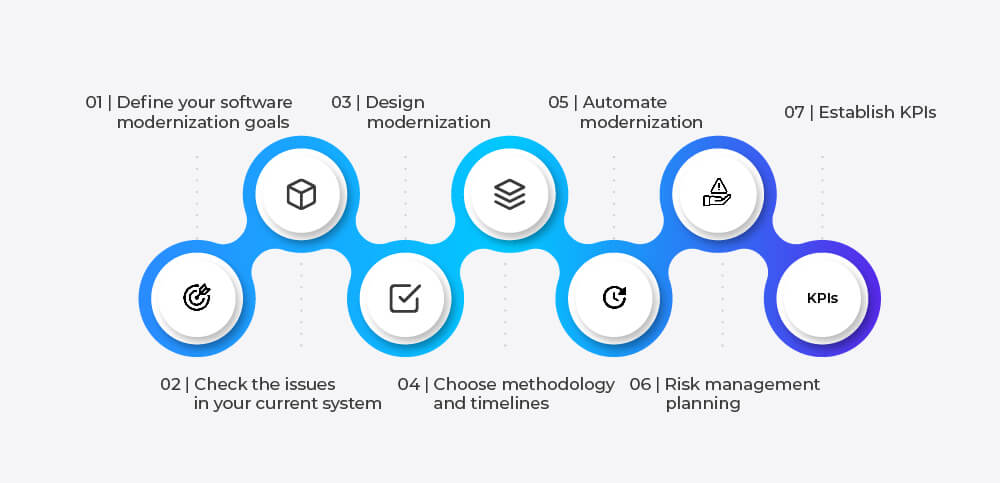
A legacy system modernization strategy is a roadmap that defines the steps to modernize an existing application or system to improve its user experience, performance, and functionality. Below are the seven steps to creating an application modernization strategy-
1. Define Your Software Modernization Goals
If you plan to switch the COBOL environment to Java, it is not going to solve the problem. In order to reap the benefits of legacy modernization, it is advised to align the modernization goals with your business objectives while focusing on scalability, new features, and quick time-to-market.
2. Check The Issues In Your Current System
Another important step in updating legacy software is finding and fixing issues. If the existing system doesn't meet your current organizational or IT requirements, it's crucial to identify and address these issues. Look for problems in the application or system that bother users, and focus on addressing those specific issues.
3. Choose The Modernization Approach
Assessing and modernizing legacy applications require a strategic approach that includes identifying the requirements, assessing possibilities, and defining a modernization strategy. Here are key legacy modernization approaches to consider while mapping out a legacy modernization strategy-
- Retain or Encapsulate: Leverages existing legacy components by encapsulating them within a new architecture. The software is accessed via APIs, enabling extended functionality.
- Rehosting: Moves application components to a different infrastructure with minimal or no code modifications. This is typically the quickest way to transition an app from on-premises to the cloud.
- Re-platforming: Migrates existing code to a new platform while retaining its structure, features, and functionality but making necessary adjustments to fit the new environment.
- Refactoring: Focuses on optimizing and restructuring the code to address issues caused by outdated elements like obsolete libraries or frameworks.
- Re-engineering: Builds upon refactoring by significantly altering the code to adopt a modern architecture with enhanced capabilities.
- Rebuild: Redesigns or rewrites the application from scratch while maintaining its original scope and specifications.
- Replace: In cases where the legacy system is no longer viable, replacing the old system with a new solution tailored to current requirements and goals is the best approach.
4. Choose Methodology And Timelines
After deciding the modernization approach, the next is to set up a clear methodology and timelines for carrying out the plan. This involves deciding the steps, assigning responsibilities, and establishing deadlines for each task. It's important to consider any dependencies or constraints that might affect the timeline.
5. Automate Modernization
The prime goal of legacy modernization is to increase value for an organization and it requires automation. Automated migration which includes refactoring legacy data to old platforms is a great way to achieve modernization. In addition, automated modernization enables organizations to modernize their systems without affecting their daily operations.
6. Risk Management Planning
Application modernization comes with some risks. To manage and minimize these risks, it is crucial to create a comprehensive risk management plan. This plan should identify potential risks, set thresholds for acceptable risk levels, create plans, and establish a systematic process for monitoring and mitigating risks throughout the modernization process.
7. Establish KPIs
The next step is to define key performance indicators (KPIs) to monitor progress. This involves pinpointing precise metrics, such as application performance, user satisfaction and delivered business value, that will be monitored to ensure the project's effectiveness.
Key Technologies for Legacy Application Modernization
Modernizing legacy applications relies on several essential technologies, including:
- Cloud Computing: Migrating to the cloud is a primary strategy for application modernization, offering scalability, flexibility, and cost-efficiency.
- Containers and Kubernetes: These tools streamline application management, enable automated processes, and support microservices-based architectures.
- Microservices: Unlike monolithic legacy applications, microservices break functionality into API-connected services, providing flexibility to adopt, upgrade, or scale components as needed.
- DevOps: By fostering cross-team collaboration and prioritizing automation and continuous delivery, DevOps ensures efficient and rapid application updates.
Things To Keep In Mind Before Modernizing Your Legacy Applications
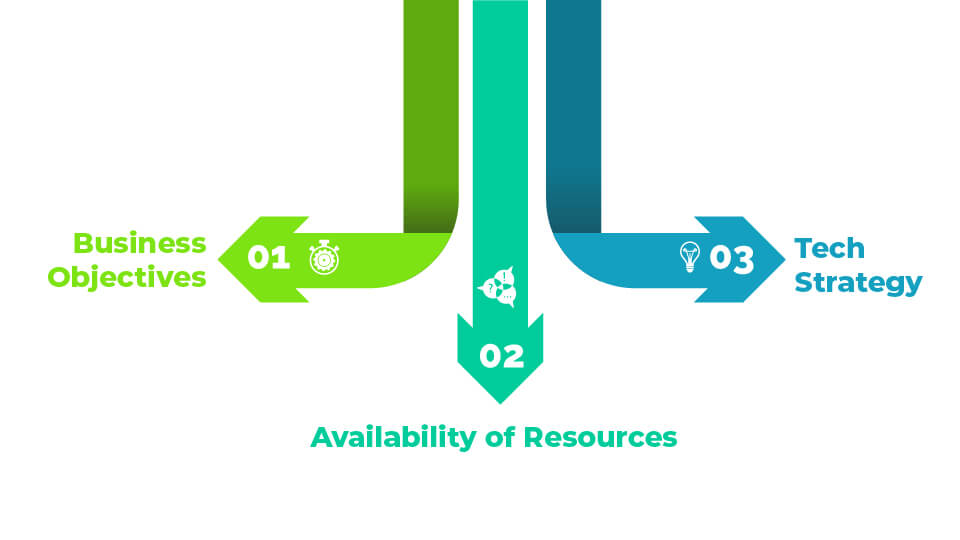
Before you start a legacy application modernization effort, there are a few things worth considering-
-
Business Objectives
Understand your company’s overall business objectives and how the application modernization effort helps you achieve these objectives, like increasing ROI, reducing costs, improving customer satisfaction, etc.
-
Availability of Resources
Since application modernization is complex, assessing your organization’s resource availability is important. This includes assessing if your enterprise has the expertise/resources to execute the modernization process.
-
Tech Strategy
Legacy application modernization is not a one-time event. Thus, it is important to have a long-term strategy to support a business’s objectives. This involves understanding a company’s existing tech landscape, and areas to improve, and defining a roadmap for technology considerations for the future.
Benefits of Legacy Application Modernization
Modernizing legacy applications brings a number of benefits for the organization, which are as follows:
- Streamlined business operations: New technology makes things much more reliable and efficient, which speeds up work and cuts down on downtime. This saves time and money because it reduces the need for manual labor and the chance of losing things.
- Satisfied customers: Legacy applications modernization improves customer interactions through an enhanced user experience. Intuitive and reliable interface has the capability to enhance overall customer satisfaction and engagement.
- Cost savings: Modernizing legacy applications not only streamlines business operations but also helps save the cost required for regular maintenance. By being more in line with existing rules, it makes expensive compliance violations less likely and eliminates the need for expensive band-aid solutions.
- Resilience: If businesses update their old systems, they can better handle future growth and technological changes. This ensures that businesses can change quickly by setting the stage for ongoing improvement and adapting to new tech environments.
Ready to take your business to the next level with modernized applications?
Bridge the gap with our expert legacy application migration services. Schedule a free consultation today to kickstart your digital transformation journey.
How Ditstek Innovations Can Help Modernize Your Legacy Applications?
Legacy application modernization is a complex process; however, it is crucial in order to keep up with the evolving business needs. Whether you are looking to update your legacy system, integrate a new solution, or redesign the enterprise system, choosing top-notch legacy application modernization services from an experienced software development company is essential for achieving both short-term and long-term goals.
In order to maintain growth and adapt to the constantly changing business landscape, it is crucial to update legacy applications. At Ditstek, our software development team have rich experience in handling legacy modernization projects for enterprise-level businesses. We can help to optimize observability, scalability and performance of your legacy applications.
FAQs
What Are The Steps to Modernize Legacy Applications?
There are many steps involved to modernize legacy applications:
- Analyze Legacy System
- Define the Problems
- Evaluate and Select the Suitable Approach
- Plan Your Modernization Scope
- Finalize Your Data and Technology Stack
- Do Your Homework to Choose the Right Modernization Partner
- Set Up Your Timeline and Define Increments
- Observe and Optimize
What Are The Key Technologies for Legacy Application Modernization?
Key Technologies for Application Modernization Include:
- Cloud
- Containers and Kubernetes
- Microservices
- Orchestration and Automation
- DevOps
- APIs
- Digital Adoption Platforms
- Data Warehouses
What Factors Drive Legacy Application Modernization?
Legacy application modernization is driven by key factors, divided between business and IT perspectives:
Business Perspective
- Business Fit: When a legacy application no longer aligns with modern digital demands, modernization ensures it meets current business needs, keeping it relevant and functional.
- Business Value: Upgrading enhances the application’s performance, usability, and ability to support strategic objectives, leading to better business outcomes.
- Flexibility: Modernization increases adaptability, allowing businesses to respond swiftly to market changes and emerging opportunities.
IT Perspective
- Cost: High total ownership costs drive the need for modernization. Updating reduces operational and maintenance expenses.
- Complexity: Outdated, complex systems can burden IT teams and disrupt operations. Modernization streamlines technology, enhancing efficiency and reducing reliance on specialized skills.
- Risk: Legacy systems often pose security, compliance, and scalability risks. Modernizing ensures adherence to current standards and readiness for future demands.
What Challenges Arise When Maintaining Legacy Applications?
Legacy applications rely on outdated technologies, making maintenance increasingly difficult. Regular updates and replacing unsupported tools are often required. Additionally, the use of outdated coding methods or unresolved bugs can complicate the process, turning the code into a puzzle.
Can Legacy Applications Scale to Meet Growing Business Needs?
No, legacy apps typically have limited scalability, making it challenging to adapt to evolving business demands or support growth effectively.
Are Legacy Applications Secure?
Legacy systems often lack robust security measures, leaving them vulnerable to cyberattacks due to outdated technologies or insufficient focus on security during development.
Do Legacy Applications Integrate Well with Modern Systems?
Not always. Many legacy apps are incompatible with newer technologies, leading to integration challenges when connecting them to modern software systems.
Is It Easy to Add New Features to Legacy Applications?
No, adding new features is often difficult due to the complex structure and dependencies of legacy applications, making modifications a time-consuming process.

Dinesh Thakur
21+ years of IT software development experience in different domains like Business Automation, Healthcare, Retail, Workflow automation, Transportation and logistics, Compliance, Risk Mitigation, POS, etc. Hands-on experience in dealing with overseas clients and providing them with an apt solution to their business needs.
Recent Posts
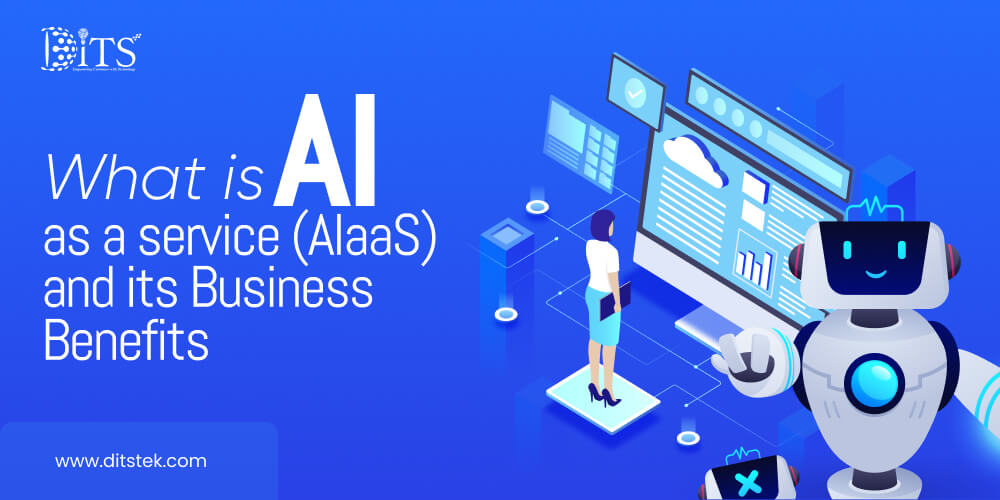
SEO services for real estate agents create s tronger visibility, trust, and qualified leads . A strategic search presence drives consisten t growth across today’s digital real estate journey.
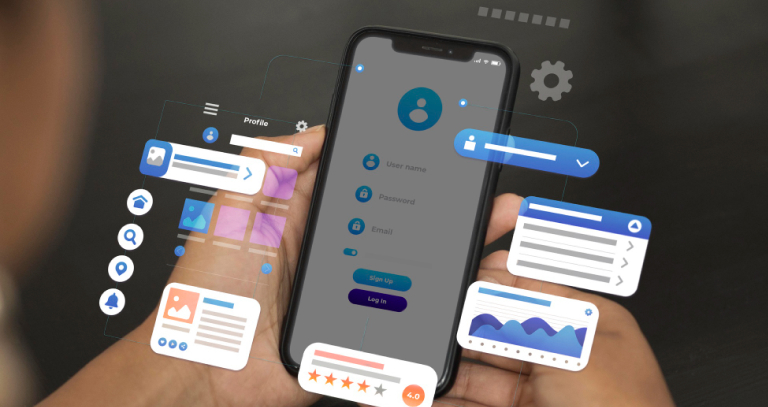
SEO services for real estate agents create s tronger visibility, trust, and qualified leads . A strategic search presence drives consisten t growth across today’s digital real estate journey.
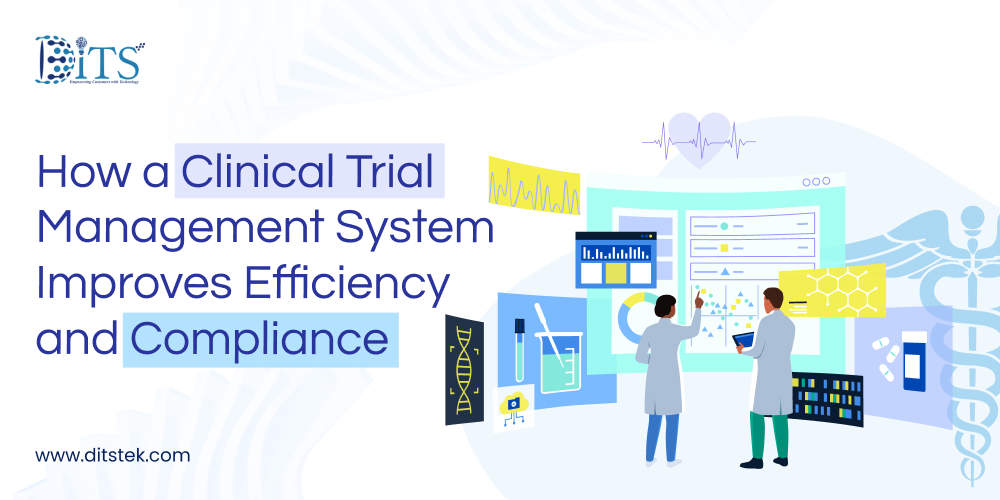
SEO services for real estate agents create s tronger visibility, trust, and qualified leads . A strategic search presence drives consisten t growth across today’s digital real estate journey.
